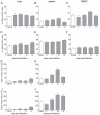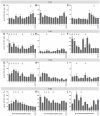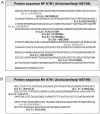Identification of novel avian influenza virus derived CD8+ T-cell epitopes
- PMID: 22384112
- PMCID: PMC3285639
- DOI: 10.1371/journal.pone.0031953
Identification of novel avian influenza virus derived CD8+ T-cell epitopes
Abstract
Avian influenza virus (AIV) infection is a continuing threat to both humans and poultry. Influenza virus specific CD8+ T cells are associated with protection against homologous and heterologous influenza strains. In contrast to what has been described for humans and mice, knowledge on epitope-specific CD8+ T cells in chickens is limited. Therefore, we set out to identify AIV-specific CD8+ T-cell epitopes. Epitope predictions based on anchor residues resulted in 33 candidate epitopes. MHC I inbred chickens were infected with a low pathogenic AIV strain and sacrificed at 5, 7, 10 and 14 days post infection (dpi). Lymphocytes isolated from lung, spleen and blood were stimulated ex vivo with AIV-specific pooled or individual peptides and the production of IFNγ was determined by ELIspot. This resulted in the identification of 12 MHC B12-restricted, 3 B4-restricted and 1 B19-restricted AIV- specific CD8+ T-cell epitopes. In conclusion, we have identified novel AIV-derived CD8+ T-cell epitopes for several inbred chicken strains. This knowledge can be used to study the role of CD8+ T cells against AIV infection in a natural host for influenza, and may be important for vaccine development.
Conflict of interest statement
Figures






Similar articles
-
Identification of a dual-specific T cell epitope of the hemagglutinin antigen of an h5 avian influenza virus in chickens.PLoS One. 2009 Nov 10;4(11):e7772. doi: 10.1371/journal.pone.0007772. PLoS One. 2009. PMID: 19901990 Free PMC article.
-
Prediction and identification of T cell epitopes in the H5N1 influenza virus nucleoprotein in chicken.PLoS One. 2012;7(6):e39344. doi: 10.1371/journal.pone.0039344. Epub 2012 Jun 20. PLoS One. 2012. PMID: 22745738 Free PMC article.
-
Revealing novel and conservative T-cell epitopes with MHC B2 restriction on H9N2 avian influenza virus (AIV).J Biol Chem. 2024 Jun;300(6):107395. doi: 10.1016/j.jbc.2024.107395. Epub 2024 May 19. J Biol Chem. 2024. PMID: 38768812 Free PMC article.
-
Revealing novel CD8+ T-cell epitopes from the H5N1 avian influenza virus in HBW/B1 haplotype ducks.Vet Res. 2024 Dec 18;55(1):169. doi: 10.1186/s13567-024-01415-6. Vet Res. 2024. PMID: 39695865 Free PMC article.
-
Avian influenza viral nucleocapsid and hemagglutinin proteins induce chicken CD8+ memory T lymphocytes.Virology. 2010 Apr 10;399(2):231-8. doi: 10.1016/j.virol.2009.12.029. Epub 2010 Feb 8. Virology. 2010. PMID: 20116819 Free PMC article.
Cited by
-
Clinical features and factors associated with outcomes of patients infected with a Novel Influenza A (H7N9) virus: a preliminary study.PLoS One. 2013 Sep 17;8(9):e73362. doi: 10.1371/journal.pone.0073362. eCollection 2013. PLoS One. 2013. PMID: 24069191 Free PMC article.
-
Epitopes in the HA and NA of H5 and H7 avian influenza viruses that are important for antigenic drift.FEMS Microbiol Rev. 2024 May 8;48(3):fuae014. doi: 10.1093/femsre/fuae014. FEMS Microbiol Rev. 2024. PMID: 38734891 Free PMC article. Review.
-
Polymorphism detection of promoter region of IFN-γ and IL-2 genes and their association with productive traits in Mazandaran native breeder fowls.J Genet. 2018 Sep;97(4):843-851. J Genet. 2018. PMID: 30262696
-
Immunogenicity and Protective Efficacy of Five Vaccines Against Highly Pathogenic Avian Influenza Virus H5N1, Clade 2.3.4.4b, in Fattening Geese.Vaccines (Basel). 2025 Apr 11;13(4):399. doi: 10.3390/vaccines13040399. Vaccines (Basel). 2025. PMID: 40333332 Free PMC article.
-
Quantification and phenotypic characterisation of peripheral IFN-γ producing leucocytes in chickens vaccinated against Newcastle disease.Vet Immunol Immunopathol. 2017 Dec;193-194:18-28. doi: 10.1016/j.vetimm.2017.10.001. Epub 2017 Oct 10. Vet Immunol Immunopathol. 2017. PMID: 29129224 Free PMC article.
References
-
- Brown IH. Summary of avian influenza activity in europe, asia, and africa, 2006–2009. Avian Dis. 2010;54(1 Suppl):187–193. - PubMed
-
- Senne DA. Avian influenza in north and south america, the caribbean, and australia, 2006–2008. Avian Dis. 2010;54(1 Suppl):179–186. - PubMed
-
- Peiris M, Yuen KY, Leung CW, Chan KH, Ip PL, et al. Human infection with influenza H9N2. Lancet. 1999;354(9182):916–917. - PubMed
-
- Koopmans M, Wilbrink B, Conyn M, Natrop G, van der Nat H, et al. Transmission of H7N7 avian influenza A virus to human beings during a large outbreak in commercial poultry farms in the netherlands. Lancet. 2004;363(9409):587–593. - PubMed
-
- World Health Organisation. Cumulative number of confirmed human cases of avian influenza A/(H5N1) reported to World Health Organisation. 2011. Final report 2011. World Health Organisation.
Publication types
MeSH terms
Substances
LinkOut - more resources
Full Text Sources
Other Literature Sources
Medical
Research Materials

